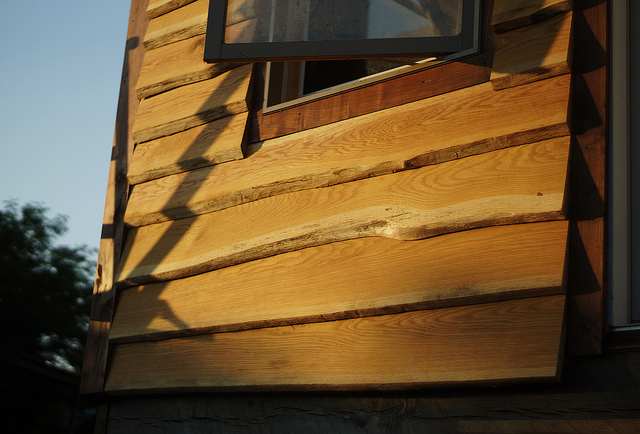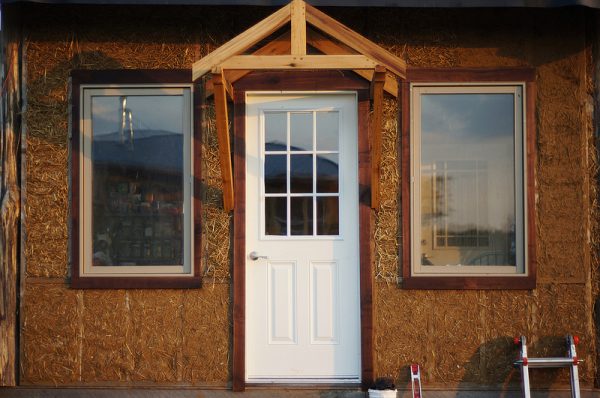An option for siding you may have seen but not known much about is live edge siding. Brian Liloia, a.k.a. Ziggy, is putting some on a strawbale home he’s building and recently shared the photo above on his blog.
Live edge siding is basically boards that have not been cut strait on one side. Instead they are left with the natural curves of the tree. You probably won’t find this kind of wood at any big box home improvement store, but through specialty suppliers or directly from the folks that milled the boards.
It takes a bit of care to cut boards like this so you might expect to pay a bit more for them. I know that seems counter intuitive because technically speaking the board is not fully cut. But any robot sawmill can cut strait boards; only someone with a careful eye can masterfully cut lengths of boards with a wild edge like this and still keep them useable as siding – covering the walls without gaps while still providing nice natural lines.
But it’s hard to argue that the extra time, money, and effort isn’t worth it… the final product is very appealing and really gives the home a unique personality.
You can follow Ziggy’s strawbale house progress on his blog. The photo below is the wall he is covering in live edge siding. Below that is a photo below that was found on Wikipedia.




I believe this is also called skirl edge siding and is caused by splitting the boards and cleaning the edges. Masterfully cutting every edge would be highly time consuming. Those edges seem to naturally follow knots and grain patterns.
We call it “Mountain Siding” here in NC. Actually, it’s easy to make if you’ve got a sawmill. You simply square an edge then just slice it up into 1″ boards. The more curves or limbs in the logs, the better. When installing it, don’t use them in the order they were cut but mix the boards for more character. Some people just side up gable ends with it but I have sided entire barns with it.
Brian is correct, that siding was popular in the PacNW, especially BC, during the 60’s and 70’s, and is called Haida Skirl (after the First Peoples). It’s a bit “dated” looking but is really superb siding. Expect it to last decades. We remodeled a beach cottage that had Haida Skirl from the late 1960’s and it was like new. It was a thick, rough sawn bevelled cedar siding that still had plenty of oils – it was a chore to paint!
Sounds like it’s time is coming again – you know how trends churn. 🙂
I agree! When we remodeled we had to source a single piece (to replace a 40′ long deck ledger). Locally, people really like it, it’s part of our beach community, which has had various eras of growth. The 60’s and 70’s houses often have the Haida Skirl; these days it’s all cement board siding (sigh). I love wood!
Also known as flitch siding. It has a long history. Flitch is derived from an Old English word.
Live Edge siding has been used frequently in NYS campgrounds, houses in the Adirondacks and in Europe for a very long time. Methods of installation will vary depending on the climate. Sources I have read re: strawbale construction usually recommend a coat of plaster on the outside of the strawbales whether it will be the outside finish or behind some other finish material. Sealing our houses tightly to conserve energy has created other issues. Here is a reference well worth reading: http://www.thelaststrawblog.org/2009/06/finishing-bale-walls-with-siding/ Whether applying wood siding over wood framed or strawbale walls, most agree that an air-gap between the siding and the wall behind it is key.
We have a mill and make this stuff all the time. We call it wavy wood. My office is made out of it, my mothers house has it, and my house under construction has it.
Do you sell wavy wood siding? If so, can you send me details on what types, and costs?
Thanks
We have been making this white pine product since 1919. Tapered, (1 inch on bottom of board, 1/4 inch on top) lays flat to each other like clapboard. Average 11 inch’s in widths, 8 feet through 16 feet long. Heat treated, (pitch set) 160 F. kiln dried 14 degrees MC. Known to last well over 100 years, and still weather tight. You can see our ad on graigs list. Plattsburgh NY